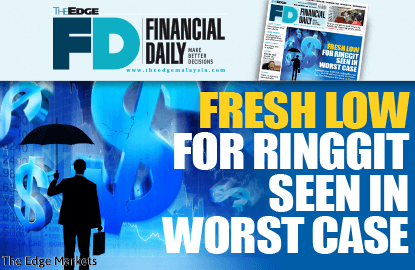
This article first appeared in The Edge Financial Daily, on November 16, 2015.
 KUALA LUMPUR: In a worst-case scenario, a US interest rate hike in December may weaken the ringgit to a fresh low of 5.00 against the US dollar if no capital measurements are applied, said independent interest rate and currency strategist Dr Suresh Ramanathan.
KUALA LUMPUR: In a worst-case scenario, a US interest rate hike in December may weaken the ringgit to a fresh low of 5.00 against the US dollar if no capital measurements are applied, said independent interest rate and currency strategist Dr Suresh Ramanathan.
However, this view is not shared by other foreign exchange (forex) strategists and economists, namely AmBank Group chief foreign exchange strategist Wong Chee Seng, United Overseas Bank (M) Bhd’s (UOB) economist Julia Goh and Moody’s assistant director and economist Emily Dabbs, who expect the ringgit to end the year at 4.20 to 4.40 to the greenback.
Ramanathan, a former forex and interest rates head with CIMB Investment Bank Bhd told The Edge Financial Daily that given that the ringgit is still under pressure, if the United States Federal Reserve (Fed) raised rates by 25 basis points in December, it is likely the currency will breach above 4.50, with stops and resistance levels of between 4.70 and 4.80 likely to be tested.
“The worst-case scenario in an environment without market related measures, the Fed raising interest rates and currently the ringgit trading around 4.25 to 4.50, the currency could quickly ascend towards USD/RM level of 5.00,” said Ramanathan, who has spent 20 years in several onshore and offshore financial institutions. Given the weaknesses of the local currency, Ramanathan highlighted that the ringgit’s fall to a new historical level is no longer an extreme view.
During the Asian financial crisis, the ringgit fell as low as 4.885 against the US dollar.
“If USD/RM was trading at 3.50 and if the market sees USD/RM at 5.00, I would say that is an extreme view. However, in the current case of USD/RM trading close to 4.50 and [the] market perceives USD/RM at 5.00, that does not construe as an extreme case anymore,” said Ramanathan.
He emphasised that his projection is based on a scenario where no market-related measures will be taken. “Given the fact there are no market-related measures introduced by the government, it is likely the ringgit will remain weak in the near term, which is to say in the next one to three months,”
Despite central bank governor Tan Sri Dr Zeti Akhtar Aziz saying the ringgit remains “significantly undervalued”, the prospect of a Fed rate hike has put the ringgit under pressure.
Year to date, the ringgit has depreciated more than 25% to 4.378 against the greenback.
According to Ramanathan, based on the real effective exchange rate (consumer price index adjusted) currently, the currency is undervalued by 5.6% (as of September 2015 and with spot USD/RM level of 4.45 in September). Ramanathan opined that Bank Negara Malaysia and the Ministry of Finance must introduce market-related measures if they intend to manage the currency, without which the ringgit would remain weak.
“It is likely that without any market-related measures being introduced, the ringgit will end the year at between 4.25 and 4.50. If indeed market-related measures are implemented, the ringgit could dip below 4.00 and end the year closer towards the 3.70 to 3.80 range,” he said.
AmBank’s Wong takes a contrarian view, expecting the pressure on the ringgit to last at least into the first half of 2016, mindful of a significant misalignment of the ringgit against its regional peers. “[Thus], we reject extreme views that the ringgit may test above 5.00 against the US dollar,” Wong replied to The Edge Financial Daily.
However, with Fed fund futures pricing an 80% probability for a December rate hike, the ringgit, like other regional currencies will continue to face a certain degree of depreciation pressure.
Wong maintained his forecast of the ringgit against the US dollar for the fourth quarter this year at 4.25. The direction of credit default swap, influence of oil prices, efforts to arrest declining forex reserves, and the interaction of risk-reward over local debts holding, are the four signposts to watch for.
Moody’s Dabbs also said that the worst case she has foreseen for the ringgit is falling to around 4.8, but it is an unlikely scenario for her now. “While the Fed rate hike will put further pressure on the ringgit, I believe it is unlikely to reach 5.00,” Dabbs, who covers regional (South Korea, Taiwan and Malaysia) economies, replied to The Edge Financial Daily in an email.
She expects the ringgit to end the year around the 4.20 mark against the US dollar as expectations for a Fed rate hike keep downward pressure on the currency. “[The] Fed will start to hike US rates either this year or early next year, and this will likely keep a lid on the ringgit,” said Dabbs.
Indeed, for Dabbs, the main risk for the ringgit is the country’s political situation, in particular with regard to problems at investment company 1Malaysia Development Bhd. “If the government can resolve the matter in a transparent way, this will boost investor sentiment and support the ringgit,” she said.
UOB economist Goh agreed that the path towards the year end will remain turbulent, but a potential Fed rate lift-off in December could also bring greater certainty about the course of the US monetary policy, which could well support some revival in risk appetite. “We expect the US dollar to remain supported as we approach the likely lift-off in US rates at the Federal Open Market Committee meeting on Dec 17. A break above 4.40 would reaffirm a more bullish US dollar trend, while support levels are at 4.30,” Goh said.